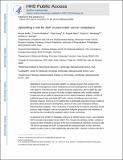| dc.contributor.author | Aiello, Nicole M. | |
| dc.contributor.author | Brabletz, Thomas | |
| dc.contributor.author | Kang, Yibin | |
| dc.contributor.author | Nieto, Maria | |
| dc.contributor.author | Weinberg, Robert A | |
| dc.contributor.author | Stanger, Ben Z. | |
| dc.date.accessioned | 2018-07-13T12:32:33Z | |
| dc.date.available | 2018-07-13T12:32:33Z | |
| dc.date.issued | 2017-07 | |
| dc.identifier.issn | 0028-0836 | |
| dc.identifier.issn | 1476-4687 | |
| dc.identifier.uri | http://hdl.handle.net/1721.1/116962 | |
| dc.description.abstract | Epithelial-to-mesenchymal transition (EMT) is a cellular program that operates in the context of embryogenesis, wound healing and carcinoma pathogenesis to drive epithelial cells towards a mesenchymal state. During carcinoma progression, EMT enables the cells forming these tumours to acquire the traits of highly malignant cells, notably motility, invasiveness and an ability to disseminate to form distant metastases. Indeed, a number of published reports have associated EMT with a variety of malignant carcinoma cells. Recently, however, Zheng et al.1 reported that in genetically engineered mouse models of pancreatic adenocarcinoma development, carcinoma cells could metastasize without activating EMT programs. Their conclusions, if sustained by the evidence presented, would prompt a major change in how we conceptualize malignant progression and metastasis of carcinoma cells, including the neoplastic cells in human carcinomas. | en_US |
| dc.publisher | Springer Nature | en_US |
| dc.relation.isversionof | http://dx.doi.org/10.1038/NATURE22963 | en_US |
| dc.rights | Creative Commons Attribution-Noncommercial-Share Alike | en_US |
| dc.rights.uri | http://creativecommons.org/licenses/by-nc-sa/4.0/ | en_US |
| dc.source | PMC | en_US |
| dc.title | Upholding a role for EMT in pancreatic cancer metastasis | en_US |
| dc.type | Article | en_US |
| dc.identifier.citation | Aiello, Nicole M., Thomas Brabletz, Yibin Kang, M. Angela Nieto, Robert A. Weinberg, and Ben Z. Stanger. “Upholding a Role for EMT in Pancreatic Cancer Metastasis.” Nature 547, no. 7661 (July 5, 2017): E7–E8. | en_US |
| dc.contributor.department | Broad Institute of MIT and Harvard | en_US |
| dc.contributor.department | Massachusetts Institute of Technology. Department of Biology | en_US |
| dc.contributor.mitauthor | Nieto, Maria | |
| dc.contributor.mitauthor | Weinberg, Robert A | |
| dc.contributor.mitauthor | Stanger, Ben Z. | |
| dc.relation.journal | Nature | en_US |
| dc.eprint.version | Author's final manuscript | en_US |
| dc.type.uri | http://purl.org/eprint/type/JournalArticle | en_US |
| eprint.status | http://purl.org/eprint/status/PeerReviewed | en_US |
| dc.date.updated | 2018-07-12T14:25:25Z | |
| dspace.orderedauthors | Aiello, Nicole M.; Brabletz, Thomas; Kang, Yibin; Nieto, M. Angela; Weinberg, Robert A.; Stanger, Ben Z. | en_US |
| dspace.embargo.terms | N | en_US |
| dc.identifier.orcid | https://orcid.org/0000-0002-0895-3557 | |
| mit.license | OPEN_ACCESS_POLICY | en_US |
